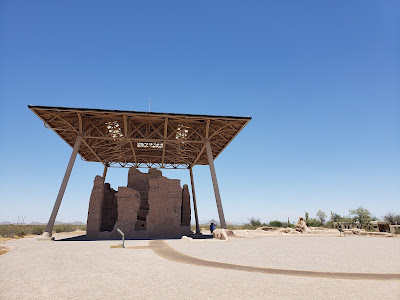Nearby town: Coolidge, AZ; nearby metro: Phoenix, AZ
In the desert southeast of Phoenix, a large, ancient structure looms over the landscape. Casa Grande National Monument protects a number of Hokoham structures dating from around 1150 - 1450 AD.
We visited this site with my sister, Anna, and her husband Jason (who works for the NPS), and my nephew Chad. It was a quick visit, and it was an incredibly HOT day. 😀 But we had a good time.
Chad, me, Jason, and Anna at the entrance sign
Your first stop should be the Visitor's Center. They have a good museum and exhibits about the ruins and the Hokoham peoples. The Hokoham inhabited this area of the American Southwest from approximately 300 - 1500 AD. They were a distinct culture but similar to the Ancestral Pueblans (whose ruins include Mesa Verde, Hovenweep, etc.) and the Mogollon (Gila Cliff Dwellings, etc.). The Hokoham tamed this seemingly inhospitable desert and developed a complex and technologically advanced society for its time - it even included large-scale irrigation networks.
example of Hokoham pottery
The centerpiece of the site is the eponymous "Big House" - a large structure made of caliche. The building consists of outer rooms, three-stories high, surrounding an inner structure. The inner structure is four-stories high, which would have made it one of the tallest buildings in North America at the time of its construction. The structure housed a number of families, essentially an entire community. There is also a ball court at the site (a popular sport among the Hokoham people). The adobe (mudbrick) that makes up the house has a very thick base, which adds significant strength to support the height of the structure. The Big House was abandoned around 1450 AD - likely due to a period of sustained drought.
The first European to see the ruins was Father Eusebio Kino in 1694. Kino, a Jesuit missionary, was instrumental in establishing missions throughout present-day Mexico and the American Southwest and traveled extensively in the area. He made detailed documentation of his travels and observations. He named the ruins "Casa Grande" (Spanish for "big house").
The ruins generated insterest for hundreds of years, and US President Benjamin Harrison protected the site via executive order in 1892. In a somewhat misguided attempt to stabilize and prop up the ruins, the US government added wooden beams and metal rods to buttress the structure. In 1918, President Woodrow Wilson re-designated the site as Casa Grande National Monument and put it under the administration of the NPS. In 1932, a ramada was built over the structure to shield it from the weather. The beams, rods, and the ramada are still present today. It is incredible that this structure still stands (and is so intact) after centuries and centuries.
Casa Grande National Monument is a good stop for an hour or two if in the area. For more info: https://www.nps.gov/cagr/index.htm

















No comments:
Post a Comment